A Systematic Mapping of the Advancing Use of Machine Learning Techniques for Predictive Maintenance in the Manufacturing Sector
Abstract
:1. Introduction
- conducting sophisticated statistical analysis, using big data analytics and machine learning algorithms to make smarter business decisions;
- optimizing operational efficiency of manufacturing assets, enabling the use of autonomous vehicles, increase production speed, reduce test time and calibration, reduce supply chain forecasting errors and result in better product availability;
- improving after sales service and enable customisation of products;
- implementing energy management initiatives, uncover important insights, fine-tune product quality, reduce the risk of shipping non-conforming parts, develop prediction of the future behaviour of the systems, detect anomalies, identify defects, and uncover the root cause of problems.
2. Research Methodology
2.1. Mapping the Process
2.2. Research Questions
- RQ1.
- How many articles cover the use of machine learning for predictive maintenance in smart manufacturing?
- RQ2.
- What type of research is being conducted in this area of ML techniques for PdM in SM?
- RQ3.
- What type of contributions are resulting from publications?
- RQ4.
- What class of equipment is a candidate to be mapped for smart manufacturing, and what is the relation between equipment and type of data under investigation?
- RQ5.
- What machine learning approaches are the most frequently applied for PdM and for which tasks are they widely used?
- RQ6.
- Which type of ML approach shows the best performance in PdM?
2.3. Scientific Database Search
2.4. Screening the Publication Content
3. Data Extraction and Documentation
3.1. Type of Equipment and Sensor Data
3.2. Machine Learning Approaches and Tasks
3.3. Machine Learning Methods
4. Results
- RQ1.
- How many articles cover the use of machine learning for predictive maintenance in smart manufacturing?
- RQ2.
- What type of research is being conducted in this area of ML techniques per PdM in SM?
- RQ3.
- What type of contributions are resulting from publications?
- RQ4.
- Whatclass of equipment is a candidate to be mapped for smart manufacturing and what is the relation between equipment and type of data under investigation?
- RQ5.
- What machine learning strategy is the most frequently applied for predictive maintenance and for which tasks is it setting?
- RQ6.
- Which machine learning strategy is the most frequently applied for predictive maintenance and for which tasks is it setting?
5. Discussion
Mitigation of Threats to Validity
6. Conclusions
Author Contributions
Funding
Data Availability Statement
Conflicts of Interest
Appendix A
| Year of Publication | Geographical Provenience | Type of Research | Type of Contribution | |
|---|---|---|---|---|
| [Koprinkova-Hristova] | 2013 | Bulgaria | evaluation | methodology |
| [Liu et al.] | 2013 | China | evaluation | model |
| [Schopka et al.] | 2013 | Germany | validation | model |
| [Susto et al.] | 2013 | Ireland | evaluation | model |
| [Wang et al.] | 2014 | China | validation | methodology |
| [Susto et al.] | 2014 | Taiwan | evaluation | tool |
| [de Souza et al.] | 2014 | Brazil | evaluation | methodology |
| [Li et al.] | 2014 | China | validation | model |
| [Kejela et al.] | 2014 | Norway | evaluation | model |
| [Lee, Kao et al.] | 2014 | United States | evaluation | framework |
| [Kroll et al.] | 2014 | Germany | evaluation | framework |
| [Lechevalier et al.] | 2014 | United States | evaluation | framework |
| [Cheng et al.] | 2015 | United States | validation | framework |
| [Munirathinam] | 2015 | India | validation | methodology |
| [Susto, Schirru et al.] | 2015 | Italy | evaluation | methodology |
| [Zhao et al.] | 2015 | China | validation | model |
| [Jahnke] | 2015 | Germany | validation | model |
| [Bluvband et al.] | 2015 | Israel | validation | methodology |
| [Sayed et al.] | 2015 | United Kingdom | validation | architecture |
| [Martín-díaz et al.] | 2015 | Spain | evaluation | methodology |
| [Wu et al.] | 2016 | United States | validation | model |
| [Jennings et al.] | 2016 | United States | validation | methodology |
| [Durbhaka and Selvaraj] | 2016 | India | validation | model |
| [Liao et al.] | 2016 | United States | validation | methodology |
| [Bosse] | 2016 | Germany | evaluation | methodology |
| [Mathew et al.] | 2017 | India | validation | model |
| [Aydin and Guldamlasioglu] | 2017 | Turkey | validation | model |
| [Diaz-Rozo et al.] | 2017 | United States | validation | architecture |
| [Luo et al.] | 2017 | China | evaluation | framework |
| [Siryani et al.] | 2017 | United States | validation | framework |
| [Jiang et al.] | 2017 | Australia | validation | framework |
| [Cline et al.] | 2017 | United States | evaluation | model |
| [Shi et al.] | 2017 | Canada | evaluation | model |
| [DiBiano and Mukhopadhyay] | 2017 | United States | evaluation | tool |
| [Ameeth and Aditya] | 2017 | India | evaluation | model |
| [Li et al.] | 2017 | Japan | validation | model |
| [Wu et al.] | 2017 | United States | validation | methodology |
| [Jinsong et al.] | 2017 | China | evaluation | model |
| [Satta et al.] | 2017 | Italy | validation | framework |
| [Guo et al.] | 2017 | China | evaluation | architecture |
| [Dong and Zhou] | 2017 | United States | validation | framework |
| [Uhlmann et al.] | 2017 | Italy | validation | model |
| [Costello et al.] | 2017 | United Kingdom | evaluation | model |
| [Alsina et al.] | 2017 | Italy | evaluation | model |
| [Irfan et al.] | 2017 | China | evaluation | methodology |
| [Canizo et al.] | 2017 | Spain | validation | methodology |
| [Mathew, Luo et al.] | 2017 | China | validation | model |
| [Li] | 2017 | China | validation | methodology |
| [Ahmad et al.] | 2017 | United States | validation | model |
| [Butte et al.] | 2018 | India | evaluation | model |
| [Zhang et al. (a)] | 2018 | China | evaluation | methodology |
| [Amrunthnah and Gupta] | 2018 | United States | evaluation | methodology |
| [Lærum] | 2018 | Norway | validation | tool |
| [Cho et al.] | 2018 | Switzerland | evaluation | architecture |
| [Ahmad et al.] | 2018 | South Korea | validation | model |
| [Abdurrahman and ElifNurdan] | 2018 | Turkey | evaluation | architecture |
| [Amruthnath and Gupta (b)] | 2018 | United States | validation | methodology |
| [Ye] | 2018 | United Kingdom | validation | model |
| [Vasilić et al.] | 2018 | Serbia | validation | methodology |
| [Oh et al.] | 2018 | Thailand | evaluation | framework |
| [Sezer et al.] | 2018 | Mexico | evaluation | process |
| [Susto et al.] | 2018 | Italy | evaluation | methodology |
| [Ren et al.] | 2018 | China | validation | framework |
| [Zhang et al. (b)] | 2018 | United States | evaluation | methodology |
| [Hundman et al.] | 2018 | United States | evaluation | methodology |
| [Kumar et al.] | 2018 | United States | validation | framework |
| [Kolokas et al.] | 2018 | Greece | evaluation | methodology |
| [Paolant et al.] | 2018 | Sweden | evaluation | architecture |
| [Lejon et al.] | 2018 | Sweden | evaluation | methodology |
| [Amihai et al.] | 2018 | Germany | validation | model |
| [Lindström] | 2018 | Sweden | evaluation | model |
| [Kulkarni et al.] | 2018 | United States | validation | model |
| [Nalbach et al.] | 2018 | Germany | evaluation | architecture |
| [Techane et al.] | 2018 | Taiwan | validation | model |
| [Flath and Stein] | 2018 | Germany | evaluation | tool |
| [Gandhi et al.] | 2018 | Sweden | evaluation | architecture |
| [Bagheri et al.] | 2018 | Kazakhstan | validation | model |
| [Kohli] | 2018 | United States | validation | model |
References
- Groumpos, P.P. Deep Learning vs. Wise Learning: A Critical and Challenging Overview. IFAC-Pap. 2016, 49, 180–189. [Google Scholar] [CrossRef]
- Goodfellow, I.; Bengio, Y.; Courville, A. Deep Learning; MIT Press: Cambridge, MA, USA, 2016. [Google Scholar]
- Gandhi, K.; Schmidt, B.; Ng, A.H.C. Towards data mining based decision support in manufacturing maintenance. Procedia Cirp 2018, 72, 261–265. [Google Scholar] [CrossRef]
- Lee, J.; Davari, H.; Singh, J.; Pandhare, V. Industrial Artificial Intelligence for Industry 4.0-Based Manufacturing Systems. Manuf. Lett. 2018, 18, 20–23. [Google Scholar] [CrossRef]
- Sharp, M.; Ak, R.; Hedberg, T. A survey of the advancing use and development of machine learning in smart manufacturing. J. Manuf. Syst. 2018, 48, 170–179. [Google Scholar] [CrossRef] [PubMed]
- Alsina, E.F.; Chica, M.; Trawiński, K.; Regattieri, A. On the use of machine learning methods to predict component reliability from data-driven industrial case studies. Int. J. Adv. Manuf. Technol. 2018, 94, 2419–2433. [Google Scholar] [CrossRef]
- Franciosi, C.; Di Pasquale, V.; Iannone, R.; Miranda, S. Multi-stakeholder perspectives on indicators for sustainable maintenance performance in production contexts: An exploratory study. J. Qual. Maint. Eng. 2020. [Google Scholar] [CrossRef]
- Duran, O.; Duran, P.A. Prioritization of physical assets for maintenance and production sustainability. Sustainability 2019, 11, 4296. [Google Scholar] [CrossRef] [Green Version]
- Franciosi, C.; Iung, B.; Miranda, S.; Riemma, S. Maintenance for sustainability in the industry 4.0 context: A scoping literature review. IFAC PapersOnLine 2018, 51, 903–908. [Google Scholar] [CrossRef]
- Nalbach, O.; Linn, C.; Derouet, M.; Werth, D. Predictive Quality: Towards a New Understanding of Quality Assurance Using Machine Learning Tools. In Business Information Systems; Abramowicz, W., Paschke, A., Eds.; Springer: Cham, Switzerland, 2018; Volume 320. [Google Scholar]
- Wang, J.; Ma, Y.; Zhang, L.; Gao, R.X.; Wu, D. Deep learning for smart manufacturing: Methods and applications. J. Manuf. Syst. 2018, 48, 144–156. [Google Scholar] [CrossRef]
- Zheng, H.W. A new intelligent fault identification method based on transfer locality preserving projection for actual diagnosis scenario of rotating machinery. Mech. Syst. Signal Process. 2020, 135, 106344. [Google Scholar] [CrossRef]
- Cho, S.; May, G.; Tourkogiorgis, I.; Perez, R.; Lazaro, O.; de la Maza, B. A hybrid machine learning approach for predictive maintenance in smart factories of the future. IFIP Adv. Inf. Commun. Technol. 2018, 536, 311–317. [Google Scholar]
- Putnik, G. Scalability in manufacturing systems design and operation: State-of-the-art and future developments roadmap. CIRP Ann. Manuf. Technol. 2013, 62, 751–774. [Google Scholar] [CrossRef]
- Lee, Y.T.; Kumaraguru, S.; Jain, S.; Robinson, S.; Helu, M.; Hatim, Q.Y. A classification scheme for smart manufacturing systems’ performance metrics. Smart Sustain. Manuf. Syst. 2017, 1, 52. [Google Scholar] [CrossRef] [PubMed]
- Susto, G.A.; Schirru, A.; Pampuri, S.; McLoone, S.; Beghi, A. Machine learning for predictive maintenance: A multiple classifier approach. IEEE Trans. Ind. Inform. 2015, 11, 812–820. [Google Scholar]
- Lee, J.; Kao, H.A.; Yang, S. Service innovation and smart analytics for Industry 4.0 and big data environment. Procedia Cirp 2014, 16, 3–8. [Google Scholar] [CrossRef] [Green Version]
- Kumar, A.; Shankar, R.; Thakur, L.S. A big data driven sustainable manufacturing framework for condition-based maintenance prediction. J. Comput. Sci. 2018, 27, 428–439. [Google Scholar] [CrossRef]
- Merkt, O. On the use of predictive models for improving the quality of industrial maintenance: An analytical literature review of maintenance strategies. In Proceedings of the 2019 Federated Conference on Computer Science and Information Systems (FedCSIS), Leipzig, Germany, 1–4 September 2019; pp. 693–704. [Google Scholar]
- Carvalho, T.P.; Soares, F.A.A.M.N.; Vita, R.; da Francisco, P.R.; Basto, J.P.; Alcalá, S.G.S. A systematic literature review of machine learning methods applied to predictive maintenance. Comput. Ind. Eng. 2020, 1, 1–12. [Google Scholar] [CrossRef]
- Sezer, E.; Romero, D.; Guedea, F.; MacChi, M.; Emmanouilidis, C. An industry 4.0-enabled low cost predictive maintenance approach for SMEs: A use case applied to a cnc turning centre. In Proceedings of the 2018 IEEE International Conference on Engineering, Technology and Innovation (ICE/ITMC), Stuttgart, Germany, 17–20 June 2018; pp. 1–8.
- Kohli, M. Using machine learning algorithms on data residing in SAP ERP application to predict equipment failures. Int. J. Eng. Technol. 2018, 7, 312–319. [Google Scholar] [CrossRef]
- Petersen, K.; Feldt, R.; Mujtaba, S.; Mattsson, M. Systematic Mapping Studies in Software Engineering. Pediatr. Neonatol. 2017, 58, 484–489. [Google Scholar]
- Paolanti, M.; Romeo, L.; Felicetti, A.; Mancini, A.; Frontoni, E.; Loncarski, J. Machine Learning approach for Predictive Maintenance in Industry 4.0. In Proceedings of the 2018 14th IEEE/ASME International Conference on Mechatronic and Embedded Systems and Applications (MESA), Oulu, Finland, 2–4 July 2018; pp. 1–6.
- Kiangala, K.S.; Wang, Z. An E_ective Predictive Maintenance Framework for Conveyor Motors Using Dual Time-Series Imaging and Convolutional Neural Network in an Industry 4.0 Environment. IEEE Access 2020, 8, 121033–121049. [Google Scholar] [CrossRef]
- Ruiz-Sarmiento, J.-R.; Monroy, J.; Moreno, F.-A.; Galindo, C.; Bonelo, J.-M.; Gonzalez-Jimenez, J. A predictive model for the maintenance of industrial machinery in the context of industry 4.0. Eng. Appl. Artif. Intell. 2020, 87, 103289. [Google Scholar] [CrossRef]
- Zhang, W.; Yang, D.; Wnag, H. Data-Driven Methods for Predictive Maintenance of Industrial Equipment: A Survey. IEEE Syst. J. 2019, 13, 2213–2227. [Google Scholar] [CrossRef]
- Ta, E.M.; Dionisio, R.P.; Torres, P.M.B. Industrial IoT devices and cyber-physical production systems: Review and use case. Lect. Notes Electr. Eng. 2019, 505, 292–298. [Google Scholar]
- Zonta, T.; da Costa, C.A.; da Rosa Righi, R.; de Lima, M.J.; da Trindade, E.S.; Li, G.P. Predictive maintenance in the Industry 4.0: A systematic literature review. Comput. Ind. Eng. 2020, 150, 106889. [Google Scholar] [CrossRef]
- Dalzochio, J.; Kunst, R.; Pignaton, E.; Binotto, A.; Sanyal, S.; Favilla, J.; Barbosa, J. Machine learning and reasoning for predictive maintenance inIndustry 4.0: Current status and challenges. Comput. Ind. 2020, 123, 103298. [Google Scholar] [CrossRef]
- Olesen, F.; Shaker, H.R. Predictive Maintenance for Pump Systems and Thermal Power Plants: State-of-the-Art Review, Trends and Challenges. Sensors 2020, 20, 2425. [Google Scholar] [CrossRef]
- Factory Integration. International Roadmap for Devices and Systems: 2020. IEEE 2020. Available online: https://irds.ieee.org/images/files/pdf/2020/2020IRDS_BC.pdf (accessed on 2 March 2021).
- Woschank, M.; Rauch, E.; Zsifkovits, H. A Review of Further Directions for Artificial Intelligence, Machine Learning, and Deep Learning in Smart Logistics. Sustainability 2020, 12, 3760. [Google Scholar] [CrossRef]
- Cai, H.; Feng, J.; Zhu, F.; Yang, Q.; Li, X.; Lee, J. Adaptive virtual metrology method based on Just-in-time reference and particle filter for semiconductor manufacturing. Measurement 2021, 168, 108338. [Google Scholar] [CrossRef]
- Siahpour, S.; Li, X.; Lee, Y. Deep learning-based cross-sensor domain adaptation for fault diagnosis of electro-mechanical actuators. Int. J. Dyn. Control 2020, 8, 1054–1062. [Google Scholar] [CrossRef]
- Lee, J.; Azamfar, M.; Singh, J.; Siahpour, S. Integration of digital twin and deep learning in cyber-physical systems: Towards smart manufacturing. IET Collab. Intell. Manuf. 2020, 2, 34–36. [Google Scholar] [CrossRef]
- Zhao, R.; Yan, R.; Chen, Z.; Mao, K.; Wang, P.; Gao, R.X. Deep learning and its applications to machine health monitoring. Mech. Syst. Signal Process. 2019, 115, 213–237. [Google Scholar] [CrossRef]
- Liao, L.; Jin, W.; Pavel, R. Prognosability Regularization for Prognostics and Health. Assessment. 2016, 63, 7076–7083. [Google Scholar]
- Amihai, I.; Pareschi, D.; Gitzel, R. Modeling machine health using gated recurrent units with entity embeddings and k-means clustering. In Proceedings of the 2018 IEEE 16th International Conference on Industrial Informatics (INDIN), Porto, Portugal, 18–20 July 2018; pp. 212–217. [Google Scholar]
- Petersen, K.; Vakkalanka, S.; Kuzniarz, L. Guidelines for conducting systematic mapping studies in software engineering: An update. Inf. Softw. Technol. 2015, 64, 1–18. [Google Scholar] [CrossRef]
- O’Donovan, P.; Leahy, K.; Bruton, K.; O’Sullivan, D.T.J. Big data in manufacturing: A systematic mapping study. J. Big Data 2015, 2, 1–22. [Google Scholar] [CrossRef] [Green Version]
- Prihatini, P.M.; Suryawan, I.K.; Mandia, I.N. Feature extraction for document text using Latent Dirichlet allocation. J. Phys. Conf. Ser. 2018, 953, 012047. [Google Scholar] [CrossRef]
- Bosse, S. Structural Monitoring with Distributed-Regional and Event-based NN-Decision Tree Learning Using Mobile Multi-Agent Systems and Common Java Script Platforms. Procedia Technol. 2016, 26, 499–516. [Google Scholar] [CrossRef] [Green Version]
- Lærum, K.H. A study of Machine Learning for Predictive Maintenance Computer Science. 2018. Available online: https://ntnuopen.ntnu.no/ntnu-xmlui/bitstream/handle/11250/2568871/19478_FULLTEXT.pdf?isAllowed=y&sequence=1 (accessed on 2 March 2021).
- Bagheri, M.; Zollanvari, A.; Nezhivenko, S. Transformer Fault Condition Prognosis Using Vibration Signals over Cloud Environment. IEEE Access 2018, 6, 9862–9874. [Google Scholar] [CrossRef]
- Kolokas, N.; Vafeiadis, T.; Ioannidis, D.; Tzovaras, D. Forecasting faults of industrial equipment using machine learning classifiers. In Proceedings of the 2018 Innovations in Intelligent Systems and Applications (INISTA), Thessaloniki, Greece, 3–5 July 2018. [Google Scholar]
- Kulkarni, K.; Devi, U.; Sirighee, A.; Hazra, J.; Rao, P. Predictive Maintenance for Supermarket Refrigeration Systems Using only Case Temperature Data. Proc. Am. Control Conf. 2018, 2018, 4640–4645. [Google Scholar]
- Satta, R.; Cavallari, S.; Pomponi, E.; Grasselli, D.; Picheo, D.; Annis, C. A dissimilarity-based approach to predictive maintenance with application to HVAC systems. arXiv 2017, arXiv:1701.03633. [Google Scholar]
- Susto, G.A.; Terzi, M.; Beghi, A. Anomaly Detection Approaches for Semiconductor Manufacturing. Procedia Manuf. 2017, 11, 2018–2024. [Google Scholar] [CrossRef]
- Ahmad, W.; Khan, S.A.; Kim, J.-M. A hybrid prognostics tech- nique for rolling element bearings using adaptive predictive models. IEEE Trans. Ind. Electron. 2018, 65, 1577–1584. [Google Scholar] [CrossRef]
- Techane, A.W.; Wang, Y.-F.; Weldegiorgis, B.H. Rotating Machinery Prognostics and Application of Machine Learning Algorithms: Use of Deep Learning with Similarity Index Measure for Health Status Prediction. In Proceedings of the Annual Conference of the Prognostics and Health Management Society, Philadelphia, PA, USA, 24 September 2018. [Google Scholar]
- Canizo, M.; Onieva, E.; Conde, A.; Charramendieta, S.; Trujillo, S. Real-time predictive maintenance for wind turbines using Big Data frameworks. In Proceedings of the 2017 IEEE International Conference on Prognostics and Health Management (ICPHM), Dallas, TX, USA, 19–21 June 2017; pp. 70–77. [Google Scholar]
- Martín-Díaz, I.; Duque-Perez, O.; Romero-Troncoso, R.; Morinigo-Sotelo, D. Supervised Diagnosis of Induction Motor Faults: A Proposed Methodology for an Improved Performance Evaluation. In Proceedings of the 2015 IEEE 10th International Symposium on Diagnostics for Electrical Machines, Power Electronics and Drives (SDEMPED), Guarda, Portugal, 1–4 September 2015; pp. 359–365. [Google Scholar]
- Durbhaka, G.K.; Selvaraj, B. Predictive maintenance for wind turbine diagnostics using vibration signal analysis based on collaborative recommendation approach. In Proceedings of the 2016 International Conference on Advances in Computing, Communications and Informatics (ICACCI), Jaipur, India, 1–24 September 2016; pp. 1839–1842. [Google Scholar]
- Aydin, O.; Guldamlasioglu, S. Using LSTM networks to predict engine condition on large scale data processing framework. In Proceedings of the 2017 4th International Conference on Electrical and Electronic Engineering (ICEEE), Ankara, Turkey, 8–10 April 2017; pp. 281–285. [Google Scholar]
- Chen, Y.E. A System Approach to Implementation of Predictive Maintenance with Machine Learning. Massachusetts Institute of Technology. Ph.D. Thesis, Massachusetts Institute of Technology, Cambridge, MA, USA, 2018. [Google Scholar]
- Zhang, J.; Wang, P.; Yan, R.; Gao, R.X. Deep Learning for Improved System Remaining Life Prediction. Procedia Cirp 2018, 72, 1033–1038. [Google Scholar] [CrossRef]
- Ahmad, S.; Lavin, A.; Purdy, S.; Agha, Z. Unsupervised real-time anomaly detection for streaming data. Neurocomputing 2017, 262, 134–147. [Google Scholar] [CrossRef]
- Amruthnath, N.; Gupta, T. A Research Study on Unsupervised Machine Learning Algorithms for Fault Detection in Predictive Maintenance. In Proceedings of the 2018 5th International Conference on Industrial Engineering and Applications (ICIEA), Singapore, 26–28 April 2018; pp. 355–361. [Google Scholar]
- Jahnke, P. Machine Learning Approaches for Failure Type Detection and Predictive Maintenance. Tech. Univ. Darmstadt 2015, 19, 83. [Google Scholar]
- Wuest, T.; Weimer, D.; Irgens, C.; Thoben, K.-D. Machine learning in manufacturing: Advantages, challenges, and applications. Prod. Manuf. Res. 2016, 4, 23–45. [Google Scholar] [CrossRef] [Green Version]
- Dey, A.; Learning, A.S. Machine Learning Algorithms: A Review. Int. J. Comput. Sci. Inf. Technol. 2016, 7, 1174–1179. [Google Scholar]
- Kumar, N.; Sharma, D. A Review on Machine Learning Algorithms, Tasks and Applications Laptop security system View project Handwritten Gurmukhi Character Recognition System. Int. J. Adv. Res. Comput. Eng. Technol. 2017, 6, 1323–2278. [Google Scholar]
- Sharp, M. Introduction to Machine Learning. J. Manuf. Syst. 2018, 101, 1–6. [Google Scholar]
- Vasilić, P.; Vujnović, V.; Popović, N.; Marjanović, A.; Marjanović, Ž. Adaboost algorithm in the frame of predictive maintenance tasks. In Proceedings of the 2018 23rd International Scientific-Professional Conference on Information Technology (IT), Zabljak, Montenegro, 19–24 February 2018; pp. 1–4. [Google Scholar]
- Mathew, V.; Toby, T.; Singh, V.; Rao, B.M.; Kumar, M.G. Prediction of Remaining Useful Lifetime (RUL) of turbofan engine using machine learning. In Proceedings of the 2017 IEEE International Conference on Circuits and Systems (ICCS), Thiruvananthapuram, India, 20–21 December 2017; pp. 306–311. [Google Scholar]
- Oh, Y.G.; Ransikarbum, K.; Busogi, M.; Kwon, D.; Kim, N. Adaptive SVM-based real-time quality assessment for primer-sealer dispensing process of sunroof assembly line. Reliab. Eng. Syst. Saf. 2018, 184, 202–212. [Google Scholar] [CrossRef]
- Amruthnath, N.; Gupta, T. Fault Class Prediction in Unsupervised Learning using Model-Based Clustering Approach. In Proceedings of the 2018 International Conference on Information and Computer Technologies (ICICT), DeKalb, IL, USA, 23–25 March 2018; pp. 5–12. [Google Scholar]
- Li, X. Remaining Useful Life Prediction of Bearings Using Fuzzy Multimodal Extreme Learning Regression. Int. Conf. Sens. Diagn. Progn. Control 2017, 1, 499–503. [Google Scholar]
- Diaz-Rozo, J.; Bielza, C.; Larrañaga, P. Machine Learning-based CPS for Clustering High throughput Machining Cycle Conditions. Procedia Manuf. 2017, 10, 997–1008. [Google Scholar] [CrossRef]
- Wang, X.; Wang, H.; Qi, C.; Sivakumar, A.I. Reinforcement learning based predictive maintenance for a machine with multiple deteriorating yield levels. J. Comput. Inf. Syst. 2014, 10, 9–19. [Google Scholar]
- Luo, M.; Yan, H.C.; Hu, B.; Zhou, J.H.; Pang, C.K. A data-driven two-stage maintenance framework for degradation prediction in semiconductor manufacturing industries. Comput. Ind. Eng. 2015, 85, 414–422. [Google Scholar] [CrossRef]
- Cheng, F.L.; Qu, Q. A case-based data-driven prediction framework for machine fault prognostics. In Proceedings of the 2015 IEEE Energy Conversion Congress and Exposition (ECCE), Montreal, QC, Canada, 20–24 Septemper 2015; pp. 3957–3963. [Google Scholar]
- Siryani, J.; Tanju, B.; Eveleigh, T.J. A Machine Learning Decision-Support System Improves the Internet of Things’ Smart Meter Operations. IEEE Internet Things J. 2017, 4, 1056–1066. [Google Scholar] [CrossRef]
- Li, J. Hard drive failure prediction using classification and regression trees. In Proceedings of the 44th Annual IEEE/IFIP International Conference on Dependable Systems and Networks, Atlanta, GA, USA, 23–26 June 2014; pp. 383–394. [Google Scholar]
- Munirathinam, S.; Ramadoss, B. Feed Forward Backpropagation Neural Network Model to Predict Remaining Useful Life Estimation of Ion Implant Tool. Int. J. Eng. Technol. 2015, 15, 64–72. [Google Scholar]
- Chang, C.-W.; Lee, H.-W.; Liu, C.-H. A Review of Artificial Intelligence Algorithms Used for Smart Machine Tools. Inventions 2018, 3, 41. [Google Scholar] [CrossRef] [Green Version]
- Koprinkova-Hristova, P. Reinforcement Learning for Predictive Maintenance of Industrial Plants. Inf. Technol. Control 2013, 11, 21–28. [Google Scholar] [CrossRef] [Green Version]
- Hundman, K.; Constantinou, V.; Laporte, C.; Colwell, I.; Soderstrom, T. Detecting Spacecraft Anomalies Using LSTMs and Nonparametric Dynamic Thresholding. In Proceedings of the 24th ACM SIGKDD international conference on knowledge discovery & data mining, London, UK, 19–23 August 2018; pp. 387–395. [Google Scholar]
- Ren, L.; Sun, Y.; Cui, J.; Zhang, L. Bearing remaining useful life prediction based on deep autoencoder and deep neural networks. J. Manuf. Syst. 2018, 48, 71–77. [Google Scholar] [CrossRef]
- Jiang, P.; Maghrebi, M.; Crosky, A.; Saydam, S. Unsupervised Deep Learning for Data-Driven Reliability and Risk Analysis of Engineered Systems. In Handbook of Neural Computation, 1st ed.; Elsevier Inc.: Amsterdam, The Netherlands, 2017. [Google Scholar]
- Cline, B.; Niculescu, B.D.; Huffman, R.S. Predictive Maintenance Applications for Machine Learning. Chin. J. Chem. 2017, 27, 1569–1574. [Google Scholar]
- Kroll, B.; Schaffranek, D.; Schriegel, S.; Niggemann, O. System modeling based on machine learning for anomaly detection and predictive maintenance in industrial plants. In Proceedings of the 2014 IEEE Emerging Technology and Factory Automation, Barcelona, Spain, 16–19 September 2014. [Google Scholar]
- Lechevalier, D.; Narayanan, A.; Rachuri, S. Towards a domain-specific framework for predictive analytics in manufacturing. In Proceedings of the 2014 IEEE International Conference on Big Data (Big Data), Washington, DC, USA, 27–30 Octocber 2014; pp. 987–995. [Google Scholar]
- Sayed, M.S.; Lohse, N.; Søndberg-Jeppesen, N.; Madsen, A.L. SelSus: Towards a reference architecture for diagnostics and predictive maintenance using smart manufacturing devices. In Proceedings of the 2015 IEEE 13th International Conference on Industrial Informatics (INDIN), Cambridge, UK, 22–24 July 2015; pp. 1700–1705. [Google Scholar]
- Wu, D.; Jennings, C.; Terpenny, J.; Kumara, S. Cloud-based machine learning for predictive analytics: Tool wear prediction in milling. In Proceedings of the 2016 IEEE International Conference on Big Data (Big Data), Washington, DC, USA, 5–8 December 2016; pp. 2062–2069. [Google Scholar]
- Liu, S.; Hu, Y.; Li, H.; Lu, C.; Zhang, H. Machinery condition prediction based on wavelet and support vector machine. J. Intell. Manuf. 2017, 28, 1045–1055. [Google Scholar] [CrossRef]
- Jinsong, B.; Yuan, G.; Xiaohu, Z.; Jianguo, Z.; Xia, J. A Data Driven Model for Predicting Tool Health Condition in High Speed Milling of Titanium Plates Using Real-Time SCADA. Procedia Cirp 2017, 61, 317–322. [Google Scholar] [CrossRef]
- Schopka, U. Practical aspects of virtual metrology and predictive maintenance model development and optimization. In Proceedings of the ASMC 2013 SEMI Advanced Semiconductor Manufacturing Conference, Saratoga Springs, NY, USA, 14–16 May 2013; pp. 180–185. [Google Scholar]
- Guo, Y.; Wu, Z.; Ji, Y. A Hybrid Deep Representation Learning Model for Time Series Classification and Prediction. In Proceedings of the 2017 3rd International Conference on Big Data Computing and Communications (BIGCOM), Chengdu, China, 10–11 August 2017; pp. 226–231. [Google Scholar]
- Lindström, J. Predictive Maintenance for a Wood Chipper Using Supervised Machine Learning. 2018. Available online: https://pdfs.semanticscholar.org/aa68/1b38ee1e9caae921f8a4589e560a9e2d447e.pdf?_ga=2.57831786.1777101615.1615205525-1148404372.1615205525 (accessed on 2 March 2021).
- Dong, W.; Zhou, M.C. A Supervised Learning and Control Method to Improve Particle Swarm Optimization Algorithms. IEEE Trans. Syst. Man Cybern. Syst. 2017, 47, 1135–1148. [Google Scholar] [CrossRef]
- Shi, F.; Liu, Y.; Liu, Z.; Li, E. Prediction of pipe performance with ensemble machine learning based approaches. J. Intell. Fuzzy Syst. 2018, 34, 3845–3855. [Google Scholar] [CrossRef]
- Langcake, S. Conditions in the Manufacturing Sector–June Quarter 2016. Available online: https://www.rba.gov.au/publications/bulletin/2016/jun/pdf/bu-0616-4.pdf (accessed on 2 March 2021).
- Flath, C.M.; Stein, N. Towards a data science toolbox for industrial analytics applications. Comput. Ind. 2018, 94, 16–25. [Google Scholar] [CrossRef]
- Susto, G.A.; McLoone, S.; Pagano, D.; Schirru, A.; Pampuri, S.; Beghi, A. Prediction of integral type failures in semiconductor manufacturing through classification methods. In Proceedings of the 2013 IEEE 18th Conference on Emerging Technologies & Factory Automation (ETFA), Cagliari, Italy, 10–13 September 2013; pp. 31–34. [Google Scholar]
- Susto, G.A. An adaptive machine learning decision system for flexible predictive maintenance. IEEE Int. Conf. Autom. Sci. Eng. 2014, 2014, 806–811. [Google Scholar]
- Jennings, C.; Member, S.; Wu, D.; Terpenny, J. Forecasting obsolescence risk and product lifecycle with machine learning. IEEE Trans. Comp. Packag. Manuf. Technol. 2016, 6, 1428–1439. [Google Scholar] [CrossRef]
- Zhang, J.; Wang, P.; Yan, R.; Gao, R.X. Long short-term memory for machine remaining life prediction. J. Manuf. Syst. 2018, 48, 78–86. [Google Scholar] [CrossRef]
- DiBiano, R.; Mukhopadhyay, S. Automated diagnostics for manufacturing machinery based on well-regularized deep neural networks. Integration 2017, 58, 303–310. [Google Scholar] [CrossRef]
- Abdurrahman, P.; ElifNurdan, P. A nocel scheme for accurate remaining useful life prediction for undustrial IoTs by using deep nerual netwrok. Int. J. Artif. Intell. Appl. 2018, 9, 17–25. [Google Scholar]
- Uhlmann, E.; Laghmouchi, A.; Geisert, C.; Hohwieler, E. Decentralized Data Analytics for Maintenance in Industrie 4.0. Procedia Manuf. 2017, 11, 1120–1126. [Google Scholar] [CrossRef]
- Lejon, E.; Kyösti, P.; Lindström, J. Machine learning for detection of anomalies in press-hardening: Selection of efficient methods. Procedia Cirp 2018, 72, 1079–1083. [Google Scholar] [CrossRef]
- Irfan, U.; Fan, Y.; Rehanullah, K.; Ling, L.; Haisheng, Y.; Bing, G. Predictive Maintenance of Power Substation Equipment by Infrared Thermography Using a Machine-Learning Approach. Energies 2017, 10, 1987. [Google Scholar]
- Costello, J.J.; West, G.M.; McArthur, S.D.J. Machine learning model for event-based prognostics in gas circulator condition monitoring. IEEE Trans. Reliab. 2017, 66, 1048–1057. [Google Scholar] [CrossRef] [Green Version]
- Mathew, J.; Luo, M.; Pang, C.K. Regression kernel for prognostics with support vector machines. In Proceedings of the 2017 22nd IEEE International Conference on Emerging Technologies and Factory Automation (ETFA), Limassol, Cyprus, 12–15 September 2017; pp. 1–5. [Google Scholar]
- Ameeth, K.; Aditya, S. Machine Learning for Predictive Maintenance of Industrial Machines using IoT Sensor Data. In Proceedings of the 2017 8th IEEE International Conference on Software Engineering and Service Science (ICSESS), Beijing, China, 24–26 November 2017. [Google Scholar]
- Butte, S.; Prashanth, A.R.; Patil, S. Machine Learning Based Predictive Maintenance Strategy: A Super Learning Approach with Deep Neural Networks. In Proceedings of the 2018 IEEE Workshop on Microelectronics and Electron Devices (WMED), Boise, ID, USA, 20–22 April 2018; pp. 1–5. [Google Scholar]
- Bluvband, Z.; Porotsky, S. RUL prognostics and critical zone recognition for suspended time-series. In Proceedings of the 2015 IEEE Conference on Prognostics and Health Management (PHM), Austin, TX, USA, 22–25 June 2015; pp. 1–5. [Google Scholar]
- Li, L.; Ota, K.; Dong, M. Deep Learning for Smart Industry: Efficient Manufacture Inspection System with Fog Computing. IEEE Trans. Ind. Inform. 2018, 14, 4665–4673. [Google Scholar] [CrossRef] [Green Version]
- Kejela, G.; Esteves, R.M.; Rong, C. Predictive Analytics of Sensor Data Using Distributed Machine Learning Techniques. In Proceedings of the 2014 IEEE 6th International Conference on Cloud Computing Technology and Science, Singapore, 15–18 December 2014; pp. 626–631. [Google Scholar]
- De Souza, D.L.; Granzotto, G.M.H.; de Almeida, M.; Oliveira-Lopes, L.C. Fault Detection and Diagnosis Using Support Vector Machines—A SVC and SVR Comparison. J. Saf. Eng. 2014, 3, 18–29. [Google Scholar] [CrossRef] [Green Version]
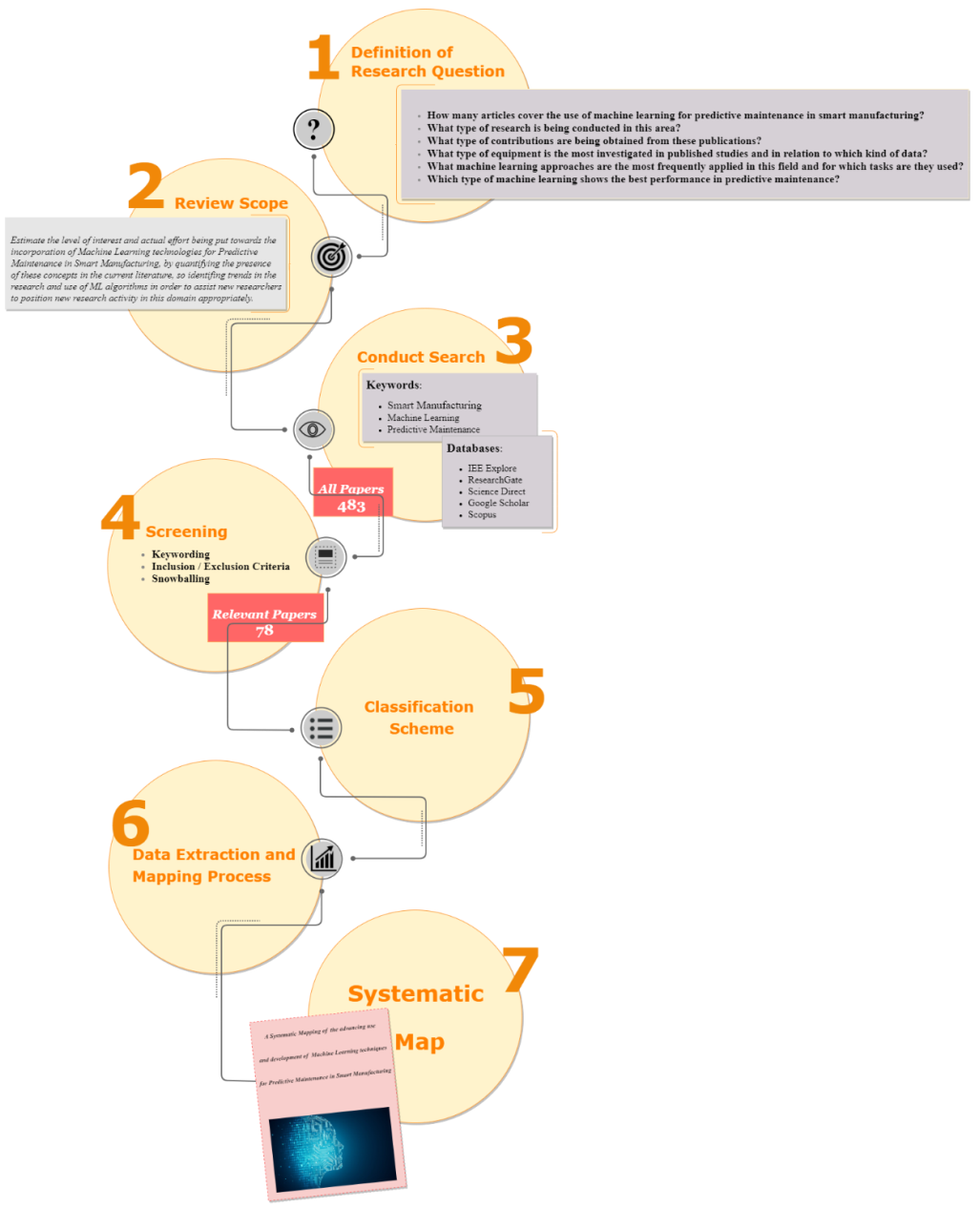
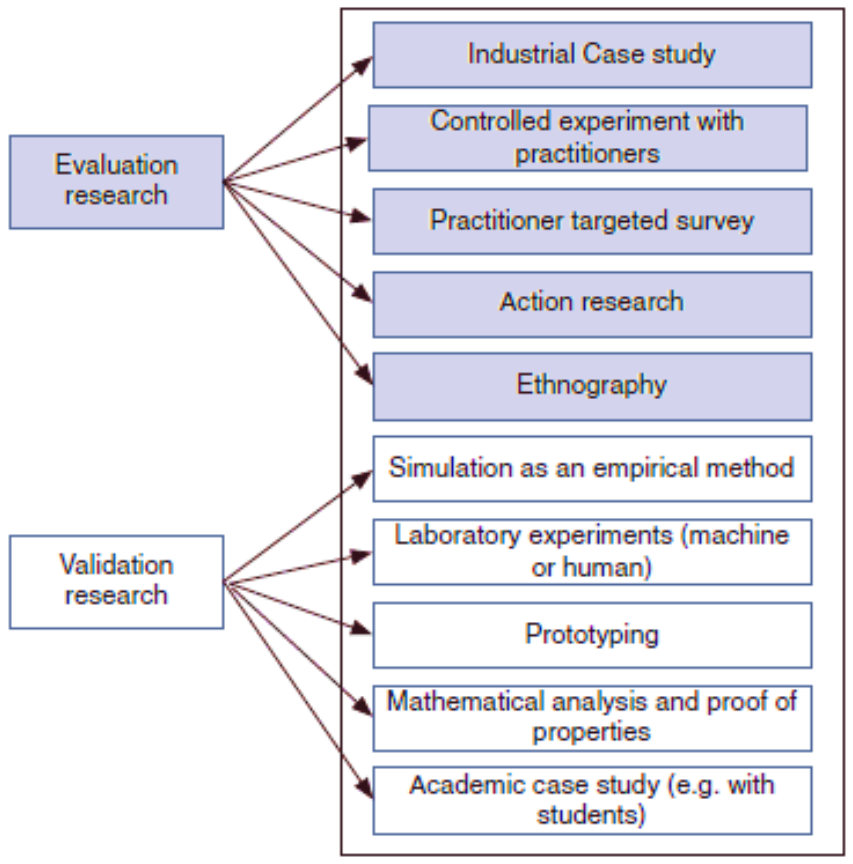
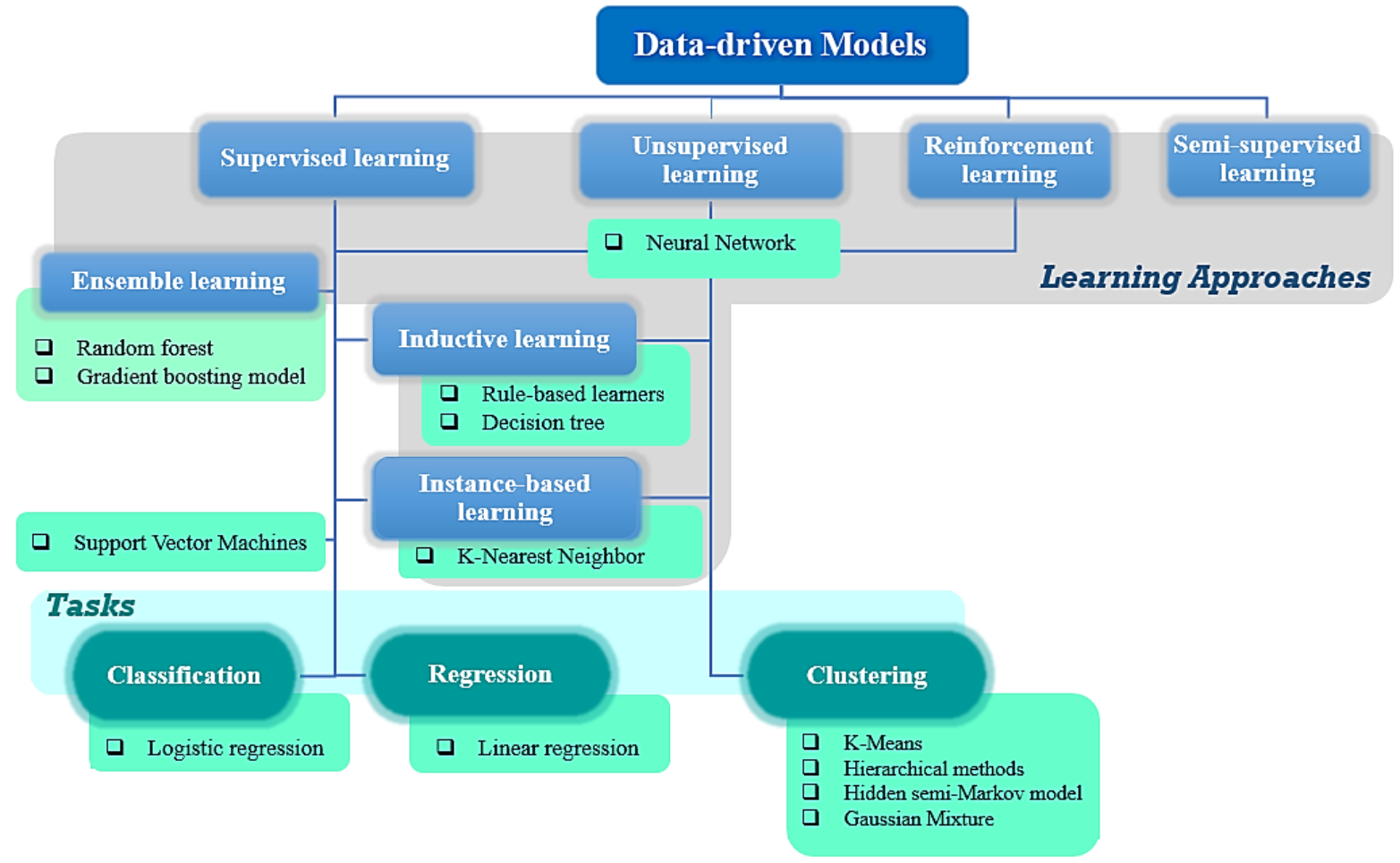




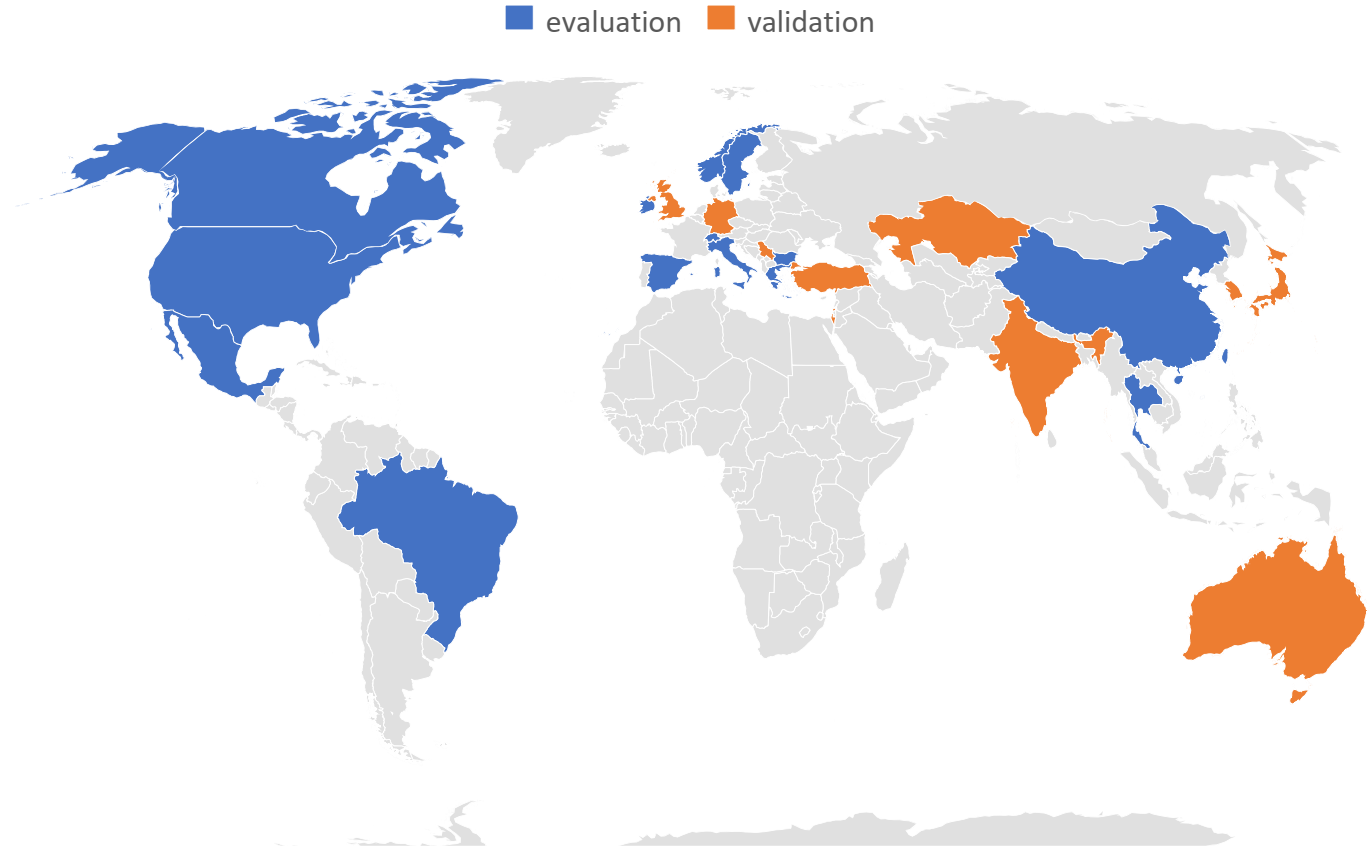


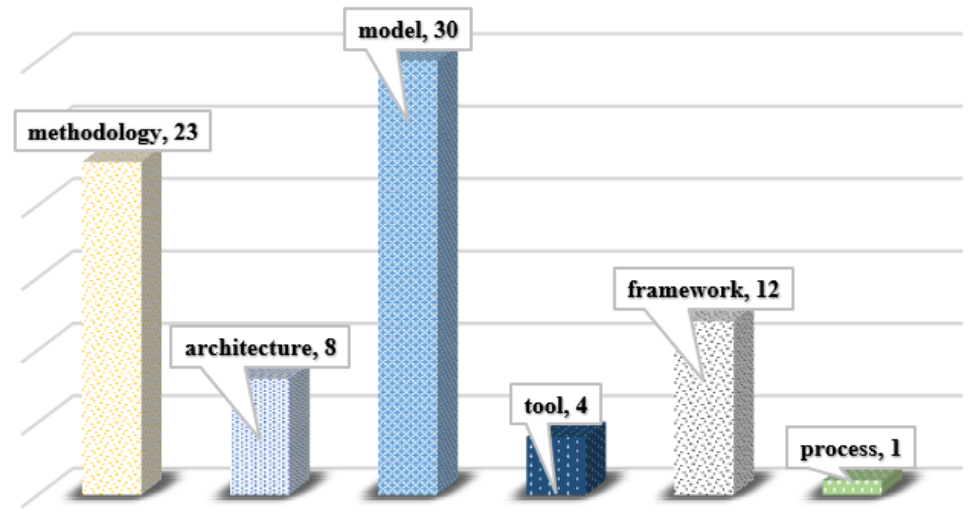
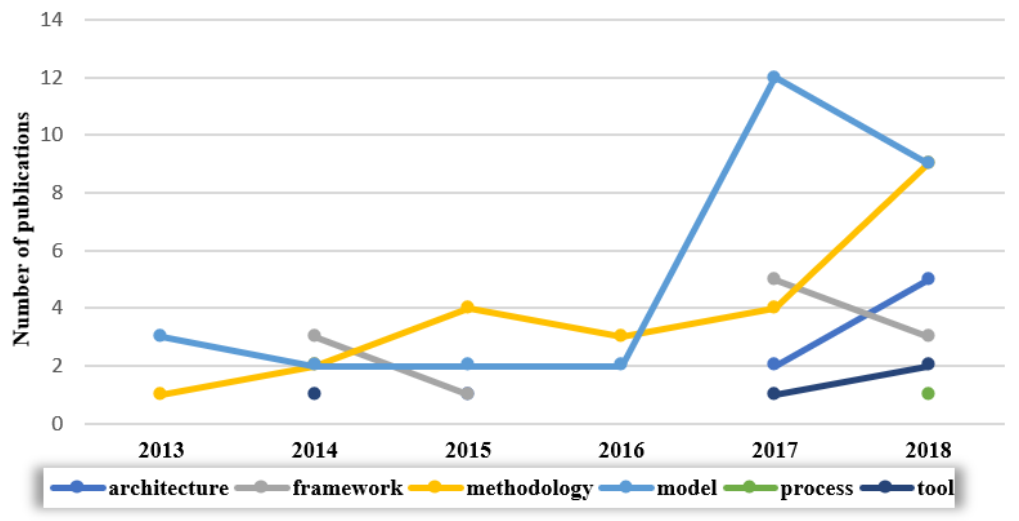
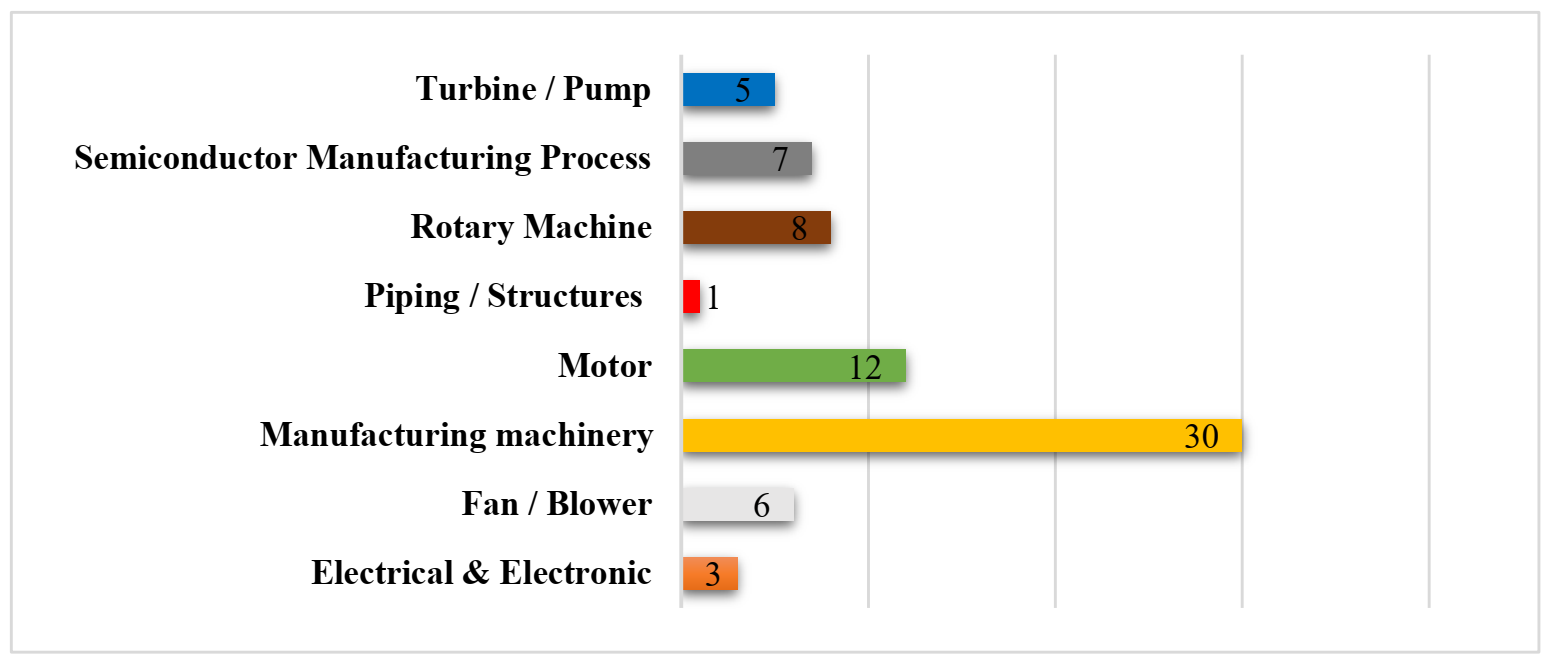



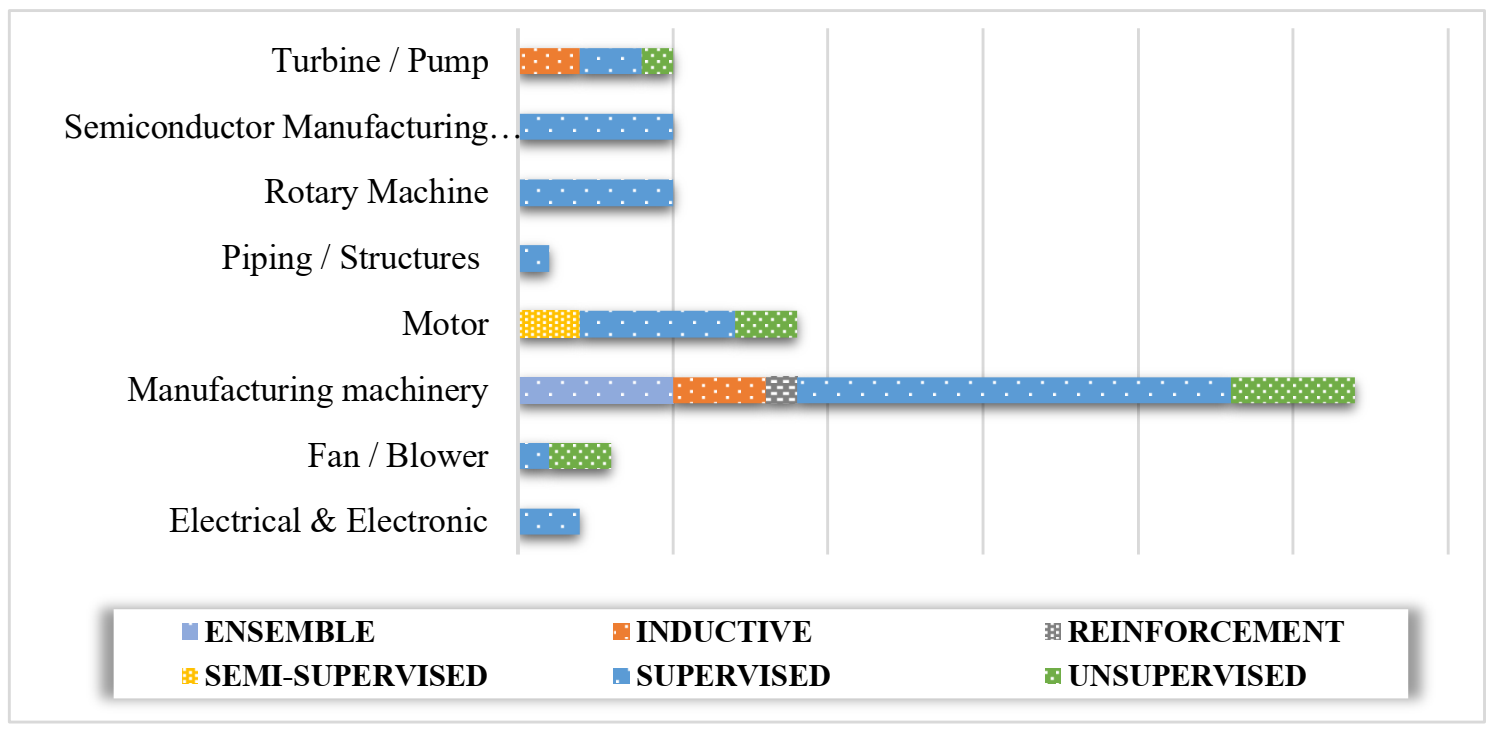
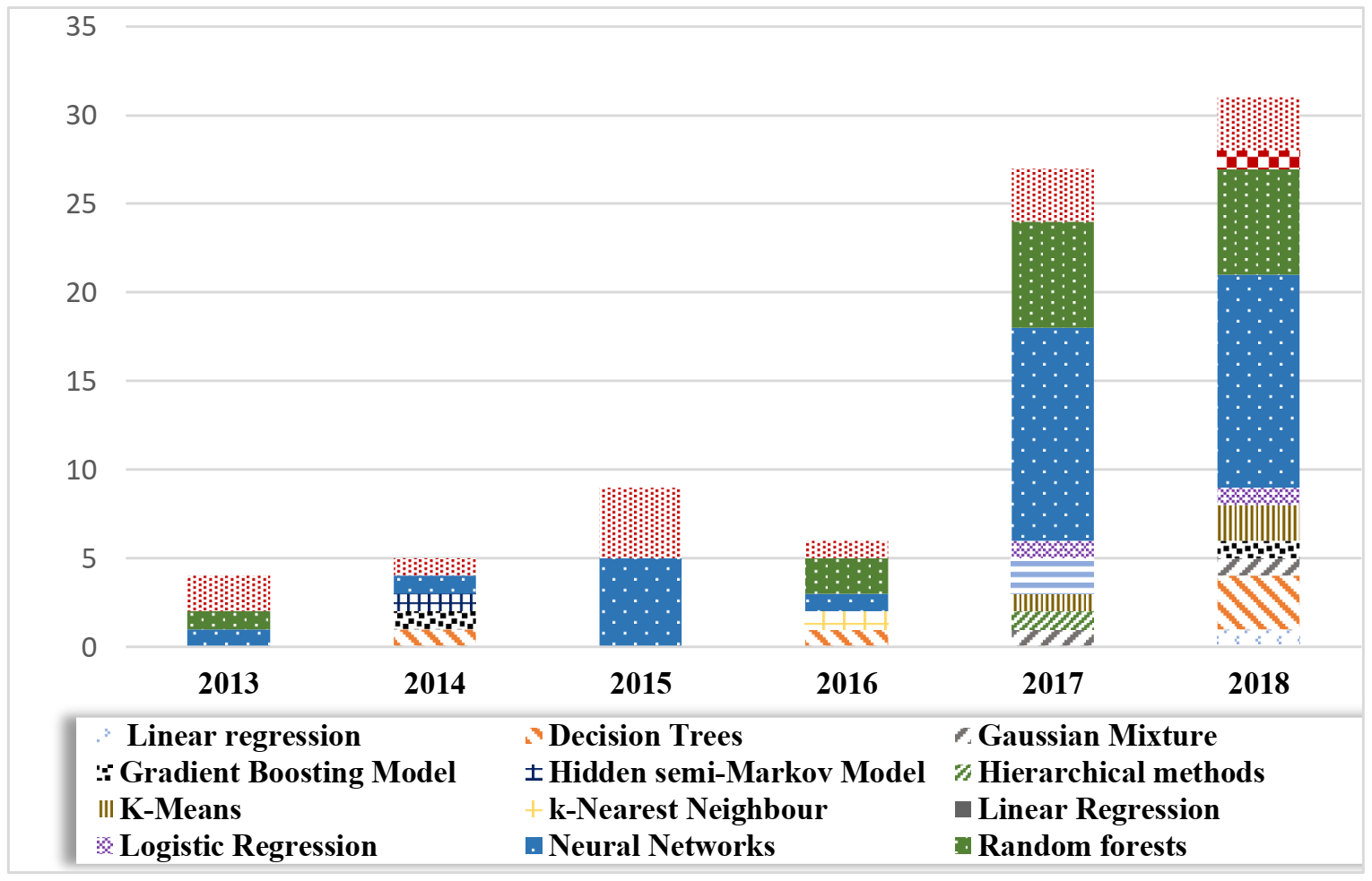
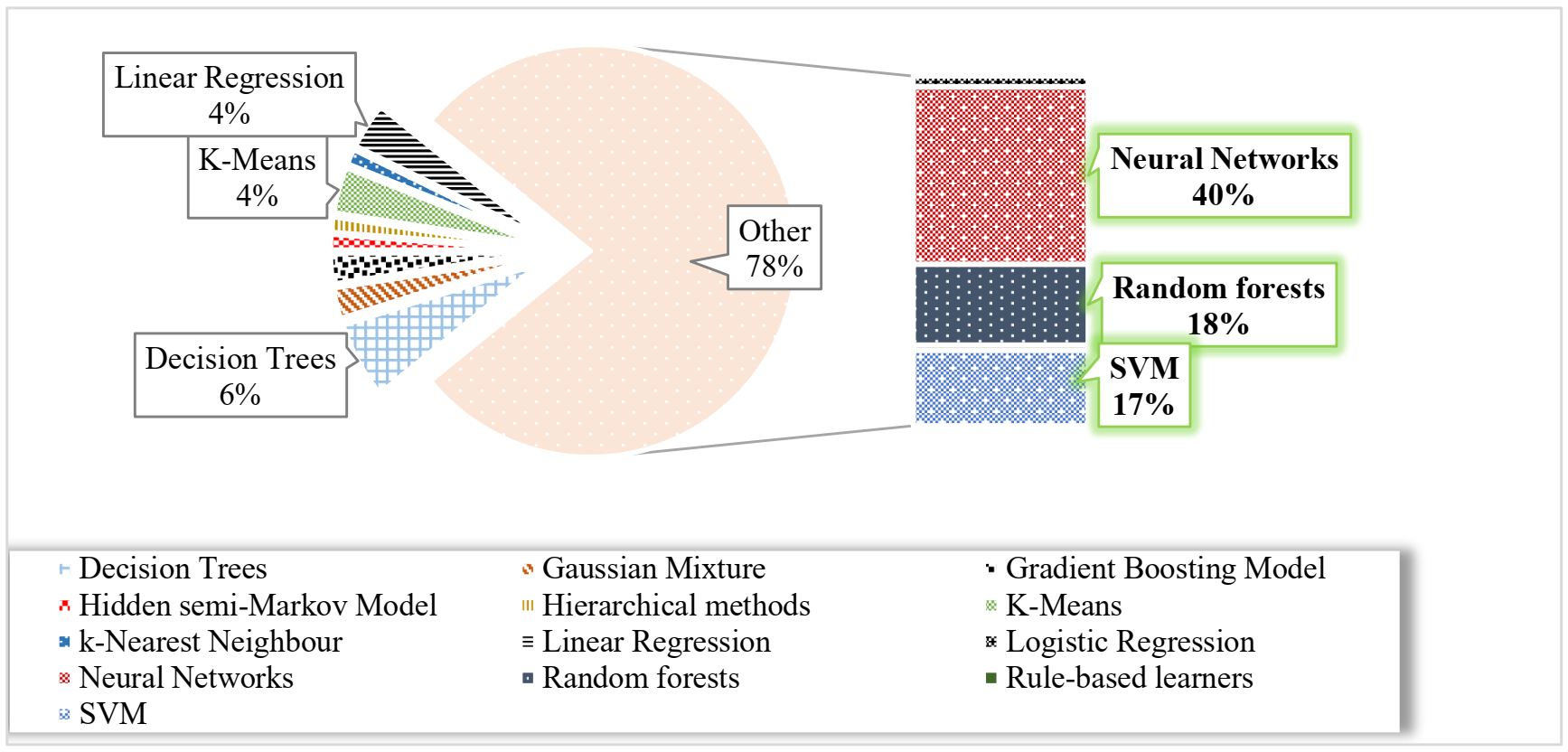

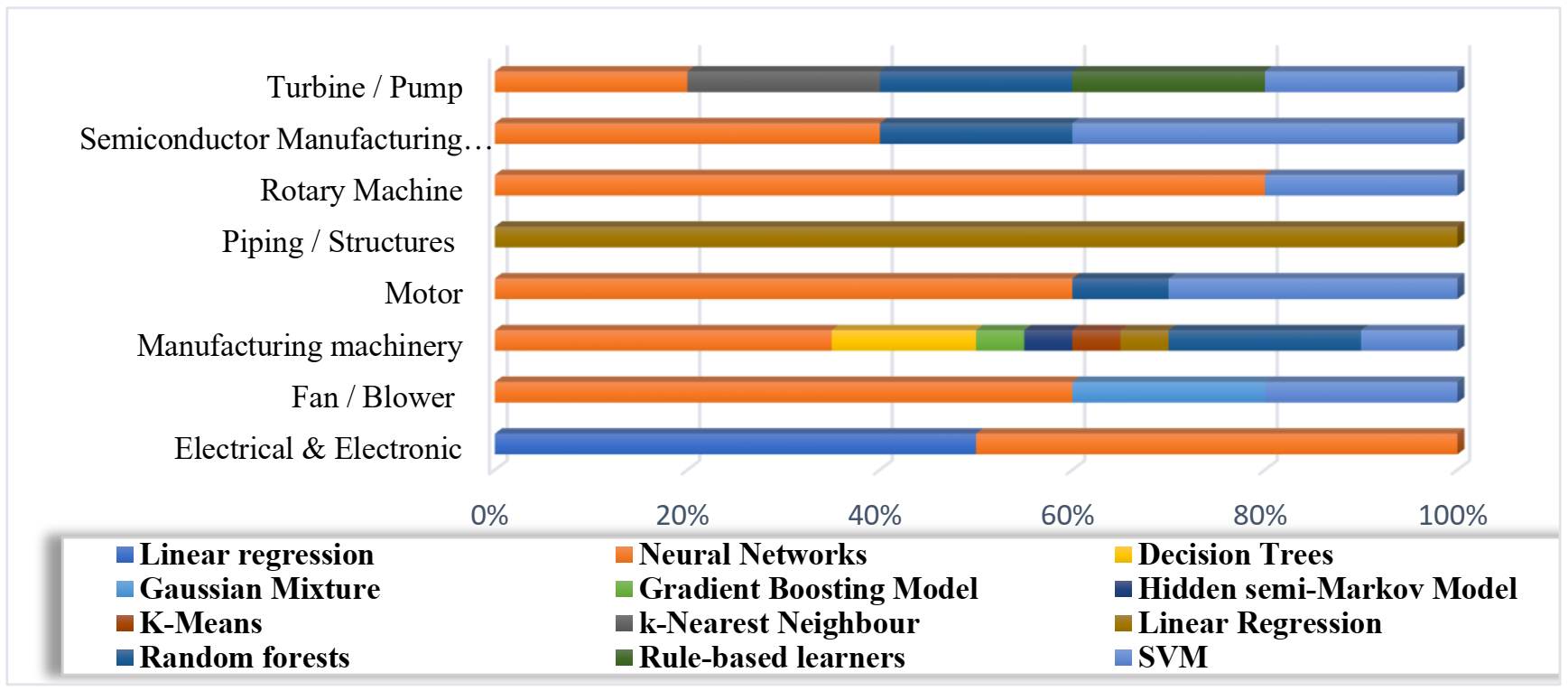
| Key Terms | Related Acceptable Terms |
|---|---|
| Smart Manufacturing | Industry 4.0, Smart industry, industrial application, semiconductor manufacturing, implant tool, industrial equipment, throughput machining, rotating machinery |
| Machine Learning | Data-driven framework, Deep Learning model, Deep Neural Networks, Long Short-Term Memory, Support Vector Machine, Reinforcement Learning, Learning Algorithms and Methods |
| Predictive Maintenance | Toll wear prediction, degradation prediction, failure prediction, Prognostics technique, Remaining Useful Life Prediction, fault detection, real-time Quality Assessment, anomaly detection, automated diagnostics, predictive analytics, Health monitoring, inspection system, detecting anomalies, fault detection and diagnosis, forecasting fault or obsolescence risk or product lifecycle, component Reliability prediction, predictive quality |
| INCLUSION CRITERIA | Technical reports, conference abstracts, review and research articles, studies and papers regarding application of ML for PdM in SM. | |
| In the field of both smart manufacturing and predictive maintenance. | ||
| Published in the time frame 2013–2019 (early included). | ||
| The focus of the paper contributes to the search topic based upon the abstract. | ||
| EXCLUSION CRITERIA | I | Studies that are only available in the form of PowerPoint presentations. |
| Studies not presented in English. | ||
| Research only containing synopsis of a full report. | ||
| Books and grey literature. | ||
| Multiple publications of an identic proposal. | ||
| II | Papers lying outside the domain of interest. | |
| Papers which only mentioned the main focus in introductory sentences in the abstract, but is not discussed in the full text study. | ||
| Type of Research | Description |
|---|---|
| VALIDATION | Theoretical Research presents a vision or a review for a topic. Research encompassing novel and unique techniques, not yet used in practise for example experiments, i.e., done in the laboratory. Philosophical paper provides a conceptual way of looking at a particular problem or field, in the form of a taxonomy or conceptual framework. Opinion paper expresses a personal interpretation about whether a particular technique is good or bad or how things should been done, without focusing on related work or standard research methods. Experience paper is written from the personal experience of the researcher, and describes how something has been done in practice. Solution proposal provides a solution, with a small example or a good line of argumentation, to a particular problem or a significant extension of an existing technique. |
| EVALUATION | Content Research validates a significant implementation of a given technique and takes place in a real-world industrial context, considering benefits and drawbacks of the solution. Implementation research includes an experiment or a case study. Commercialization research presents a novel solution that is fully commercialized. |
| Type of Contribution | Explanation of Research Content |
|---|---|
| METHODOLOGY | Research that presents instructions or methods, with low-level approaches, to assist in solving a problem. |
| ARCHITECTURE | Research that describes a theoretical view of a system where different components interact with each other in solving a problem. |
| MODEL | Research that outlines mathematical models or algorithms for solving particular problems. |
| TOOL | Research that develops well-defined software utilities that address a subset of a bigger problem or a device that serves a particular function and it can be integrated within identified machines. |
| FRAMEWORK | Research that describes the encapsulation of multiple software libraries that solve a particular problem, while also being extensible. |
| PROCESS | Research that presents low-level processes to solving a particular problem. |
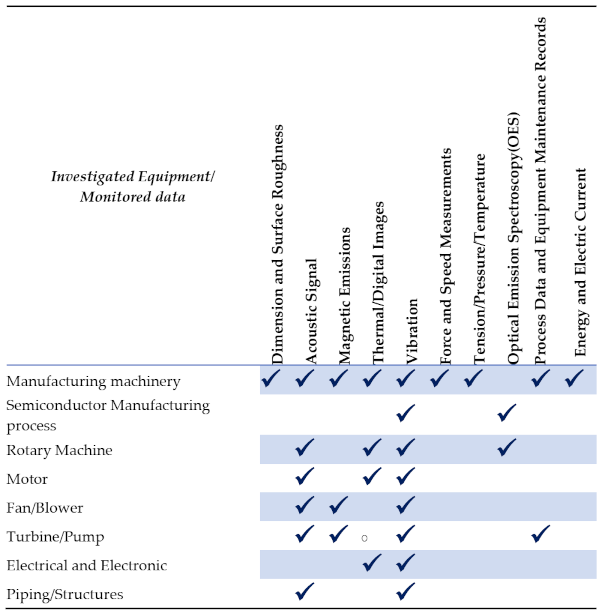
Publisher’s Note: MDPI stays neutral with regard to jurisdictional claims in published maps and institutional affiliations. |
© 2021 by the authors. Licensee MDPI, Basel, Switzerland. This article is an open access article distributed under the terms and conditions of the Creative Commons Attribution (CC BY) license (http://creativecommons.org/licenses/by/4.0/).
Share and Cite
Nacchia, M.; Fruggiero, F.; Lambiase, A.; Bruton, K. A Systematic Mapping of the Advancing Use of Machine Learning Techniques for Predictive Maintenance in the Manufacturing Sector. Appl. Sci. 2021, 11, 2546. https://doi.org/10.3390/app11062546
Nacchia M, Fruggiero F, Lambiase A, Bruton K. A Systematic Mapping of the Advancing Use of Machine Learning Techniques for Predictive Maintenance in the Manufacturing Sector. Applied Sciences. 2021; 11(6):2546. https://doi.org/10.3390/app11062546
Chicago/Turabian StyleNacchia, Milena, Fabio Fruggiero, Alfredo Lambiase, and Ken Bruton. 2021. "A Systematic Mapping of the Advancing Use of Machine Learning Techniques for Predictive Maintenance in the Manufacturing Sector" Applied Sciences 11, no. 6: 2546. https://doi.org/10.3390/app11062546
APA StyleNacchia, M., Fruggiero, F., Lambiase, A., & Bruton, K. (2021). A Systematic Mapping of the Advancing Use of Machine Learning Techniques for Predictive Maintenance in the Manufacturing Sector. Applied Sciences, 11(6), 2546. https://doi.org/10.3390/app11062546





